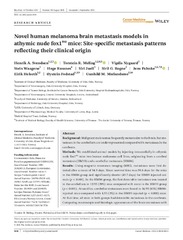Blar i forfatter "Fodstad, Øystein"
-
Clinical significance of disseminated tumour cells in non-small cell lung cancer
Rud, Ane Kristine Kongsgaard; Borgen, Elin; Mælandsmo, Gunhild; Flatmark, Kjersti; Le, Hang Ngoc Thi; Josefsen, Dag; Solvoll, Ingjerd; Schirmer, Cecilie; Helland, Åslaug; Jørgensen, Lars Hilmar; Brustugun, Odd Terje; Fodstad, Øystein; Boye, Kjetil (Journal article; Tidsskriftartikkel; Peer reviewed, 2013-08-13)Background: Early-stage non-small cell lung cancer (NSCLC) patients have a high risk of disease relapse despite curatively intended surgical resection, and the detection of tumour cells in the bone marrow could be one method of determining the presence of the disseminated disease in its early stages.<p> <p>Methods: Bone marrow aspirates were collected from 296 patients at the time of surgery, and ... -
Correlation of expression of Major Vault Protein with androgen receptor and immune checkpoint protein B7-H3, and with poor prognosis in prostate cancer
Nunes-Xavier, Caroline Elisabeth; Emaldi, Maite; Guldvik, Ingrid Jenny; Ramberg, Håkon; Tasken, Kristin Austlid; Mælandsmo, Gunhild Mari; Fodstad, Øystein; Llarena, Roberto; Pulido, Rafael; Lopez, José I. (Journal article; Tidsskriftartikkel; Peer reviewed, 2022-11-24)Prostate cancer diagnosis and early stratification is an important aspect to avoid undertreatment of high-risk prostate cancer patients. Major Vault Protein (MVP) has been proposed as a prognostic biomarker in prostate cancer. PTEN and the immune checkpoint protein B7-H3 interact with MVP and are important in prostate cancer progression and therapy response. We evaluated the expression of MVP by ... -
Detection of disseminated tumor cells in lymph nodes from patients with early stage non-small cell lung cancer
Rud, Ane Kristine Kongsgaard; Pedersen, Kjetil Boye; Fodstad, Øystein; Juell, Siri; Jørgensen, Lars Hilmar; Solberg, Steinar; Helland, Åslaug; Brustugun, Odd Terje; Mælandsmo, Gunhild (Journal article; Tidsskriftartikkel; Peer reviewed, 2016-06-17)Background: The regional lymph node involvement is a major prognostic factor in patients with non-small cell lung cancer (NSCLC) undergoing surgical resection. Disease relapse is common, suggesting that early disseminated disease is already present in the regional lymph nodes at the time of surgery, and that the current nodal staging classification might be suboptimal. Early detection of disseminated ... -
The expression pattern of pyruvate dehydrogenase kinases predicts prognosis and correlates with immune exhaustion in clear cell renal cell carcinoma
Nunes-Xavier, Caroline Elisabeth; Emaldi, Maite; Mingo, Janire; Øyjord, Tove Ragnhild; Mælandsmo, Gunhild Mari; Fodstad, Øystein; Errarte, Peio; Larrinaga, Gorka; Llarena, Roberto; López, José I.; Pulido, Rafael (Journal article; Tidsskriftartikkel; Peer reviewed, 2023-05-05)Renal cancer cells constitute a paradigm of tumor cells with a glycolytic reprogramming which drives metabolic alterations favouring cell survival and transformation. We studied the expression and activity of pyruvate dehydrogenase kinases (PDK1-4), key enzymes of the energy metabolism, in renal cancer cells. We analysed the expression, subcellular distribution and clinicopathological correlations ... -
Increased Local Inflammatory Response to MOC31PE Immunotoxin After Cytoreductive Surgery and Hyperthermic Intraperitoneal Chemotherapy
Thorgersen, Ebbe Billmann; Asvall, Jørund; Frøysnes, Ida Storhaug; Schjalm, Camilla; Larsen, Stein Gunnar; Dueland, Svein; Andersson, Yvonne; Fodstad, Øystein; Mollnes, Tom Eirik; Flatmark, Kjersti (Journal article; Tidsskriftartikkel; Peer reviewed, 2021-05-21)Background - Despite extensive cytoreductive surgery and hyperthermic intraperitoneal chemotherapy (CRS-HIPEC), most patients with resectable peritoneal metastases from colorectal cancer experience disease relapse. MOC31PE immunotoxin is being explored as a novel treatment option for these patients. MOC31PE targets the cancer-associated epithelial cell adhesion molecule, and kills cancer cells by ... -
LIMT is a novel metastasis inhibiting lncRNA suppressed by EGF and downregulated in aggressive breast cancer
Sas-Chen, Aldema; Aure, Miriam Ragle; Leibovich, Limor; Carvalho, Silvia; Enuka, Yehoshua; Körner, Cindy; Polycarpou-Schwarz, Maria; Lavi, Sara; Nevo, Nava; Kuznetsov, Yuri; Yuan, Justin; Azuaje, Francisco; Ulitsky, Igor; Diederichs, Sven; Wiemann, Stefan; Yakhini, Zohar; Kristensen, Vessela N.; Børresen-Dale, Anne-Lise; Yarden, Yosef; Sauer, Torill; Geisler, Jürgen; Hofvind, Solveig; Bathen, Tone Frost; Borgen, Elin; Engebråten, Olav; Fodstad, Øystein; Garred, Øystein; Geitvik, Gry; Kåresen, Rolf; Naume, Bjørn; Mælandsmo, Gunhild; Russnes, Hege Elisabeth Giercksky; Schlichting, Ellen; Sørlie, Therese; Lingjærde, Ole Christian; Sahlberg, Kristine Kleivi; Skjerven, Helle; Fritzman, Britt (Journal article; Tidsskriftartikkel; Peer reviewed, 2016-09-01)Long noncoding RNAs (lncRNAs) are emerging as regulators of gene expression in pathogenesis, including cancer. Recently, lncRNAs have been implicated in progression of specific subtypes of breast cancer. One aggressive, basal-like subtype associates with increased EGFR signaling, while another, the HER2-enriched subtype, engages a kin of EGFR Based on the premise that EGFR-regulated lncRNAs might ... -
Novel human melanoma brain metastasis models in athymic nude fox1nu mice: Site-specific metastasis patterns reflecting their clinical origin
Svendsen, Henrik Aasrum; Meling, Torstein Ragnar; Nygaard, Vigdis; Waagene, Stein; Russnes, Hege Elisabeth Giercksky; Juell, Siri; Rogne, Siril Gudmundson; Pahnke, Jens; Helseth, Eirik; Fodstad, Øystein; Mælandsmo, Gunhild Mari (Journal article; Tidsskriftartikkel; Peer reviewed, 2021-10-06)Background: Malignant melanomas frequently metastasize to the brain, but metastases in the cerebellum are underrepresented compared with metastases in the cerebrum.<p> <p>Methods: We established animal models by injecting intracardially in athymic nude fox1<sup>nu</sup> mice two human melanoma cell lines, originating from a cerebral metastasis (HM19) and a cerebellar metastasis (HM86).<p> <p>Results: ... -
p38 MAPK activation through B7-H3-mediated DUSP10 repression promotes chemoresistance
Flem-Karlsen, Karine; Tekle, Christina; Øyjord, Tove Ragnhild; Flørenes, Vivi Ann; Mælandsmo, Gunhild Mari; Fodstad, Øystein; Nunes-Xavier, Caroline Elisabeth (Journal article; Tidsskriftartikkel; Peer reviewed, 2019-04-09)Immunoregulatory protein B7-H3 is involved in the oncogenic and metastatic potential of cancer cells, as well as in drug resistance. Resistance to conventional chemotherapy is an important aspect of melanoma treatment, and a better understanding of how B7-H3 enhances drug resistance may lead to the development of more effective therapies. We investigated the <i>in vitro</i> and <i>in vivo</i> ...


 English
English norsk
norsk






